
The Bentheimer Landschaf (also known as Landrace of Bentheim) is a breed of domesticated sheep found in Germany. This breed is a cross between German and Dutch heath sheep and a marsh sheep. It is primarily used for landscape preservation. [1]

The Bentheimer Landschaf (also known as Landrace of Bentheim) is a breed of domesticated sheep found in Germany. This breed is a cross between German and Dutch heath sheep and a marsh sheep. It is primarily used for landscape preservation. [1]
The Bentheimer Landschaf displays white and has black around the eyes, ears and legs. [2] The fleece weighs 3 to 4 kg (6.6 to 8.8 lb) with a fiber diameter of 34 to 40 micrometres. [1]
Ewes weigh on average 60 kg (130 lb) and grow to 67 cm (26 in) at the withers at maturity. [2]

The Lincoln, sometimes called the Lincoln Longwool, is a breed of sheep from England. The Lincoln is the largest British sheep, developed specifically to produce the heaviest, longest and most lustrous fleece of any breed in the world. Great numbers were exported to many countries to improve the size and wool quality of their native breeds. The versatile fleece is in great demand for spinning, weaving and many other crafts.

The Oxford Down is an English breed of domestic sheep developed in the 1830s by crossing the Cotswold, Hampshire and South Down breeds, and using the resulting cross-breeds to form the basis of the present-day breed. This breed is primarily raised for meat.

The Targhee is a breed of domestic sheep developed in early 20th century by the USDA's Agricultural Research Service. Targhee sheep are a dual-purpose breed, with heavy, medium quality wool and good meat production characteristics. They are hardy, and are especially suited to the ranges of the West where they were developed. Targhee are especially popular in Montana, Wyoming and South Dakota, where their ¾ fine wool and ¼ long wool breeding is favored by western ranchers. This breed is raised primarily for wool.
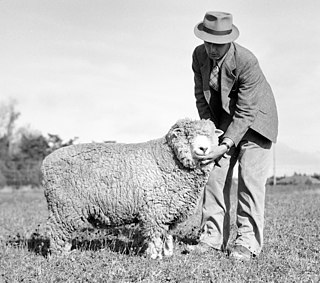
Corriedale sheep are a dual purpose breed, meaning they are used both in the production of wool and meat. The Corriedale is the oldest of all the crossbred breeds, a Merino-Lincoln cross developed almost simultaneously in Australia and New Zealand and first brought to the United States in 1914. The Corriedale is internationally farmed, in Australia, New Zealand, the United States of America, Southern Brazil, Uruguay and Patagonia. Corriedales are one of the most popular sheep breeds in Uruguay. On the Falkland Islands, Polwarth and Corriedale form the main sheep breeds.

The Bluefaced Leicester (BFL) is a longwool breed of sheep which evolved from a breeding scheme of Robert Bakewell, in Dishley, Leicestershire in the eighteenth century. First known as the Dishley Leicester, and then the Hexham Leicester, because of the prevalence of the breed in Northumberland, the name Bluefaced Leicester became known at the beginning of the 20th century. In the 1970s, the Bluefaced Leicester was exported to Canada. Exported frozen semen from the United Kingdom is now used to expand the genetic diversity in Canada and the United States. This breed is raised primarily for meat, but their fleece is becoming increasingly popular for handspinning. Bluefaced Leicester sheep may also have brown on their face. The sell record has been set by a brown ram lamb selling for 23,000 guineas.

The Blackhead Persian is a fat-tailed breed of domestic sheep from Africa. The sheep is originally from Somaliland and a direct descendant of the Somali sheep. The breed is also a type of hair sheep, meaning they do not grow wool and tolerate heat better than wooled breeds and are raised primarily for meat. The Blackhead Persian has a white body and, as their name would suggest, an entirely black head.
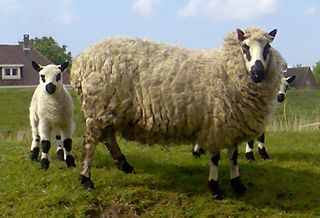
The Kerry Hill is a breed of domestic sheep originating in the county of Powys in Wales. It derives its name from the village of Kerry (Ceri), near Newtown. Kerry Hill sheep have a distinctive and unique coloration, with a white face bearing black markings around the mouth, ears, and eyes. Both rams and ewes are polled. Their wool is white, and their legs are white with black markings. First mentions of the breed date back to the early 19th century, and today it is distributed throughout the United Kingdom, Ireland, the Netherlands, Germany and Denmark. Though still not very numerous, the breed was removed from the records of the Rare Breeds Survival Trust watchlist in 2006. This breed is primarily raised for meat.
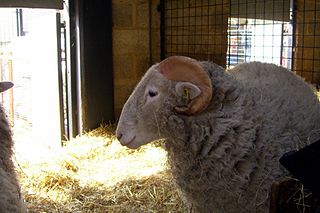
The Whitefaced Woodland is a sheep breed from the Woodlands of Hope an area in the South Pennines in England. It is a combination of two breeds, the Woodland and the Penistone sheep after the Yorkshire town where sheep sales have been held since 1699. It is thought to be closely related to the Swaledale and the Lonk. Substantial commercial flocks of the Whitefaced Woodland are kept in its region of origin, but it is listed as a vulnerable breed by the Rare Breeds Survival Trust, since there are fewer than 900 registered breeding females in Great Britain.

The Basco-béarnaise is a domesticated breed of sheep originating in the Basque country. The breed was developed from Basque and Béarnaise sheep during the 1960s to be a single-purpose milk breed.
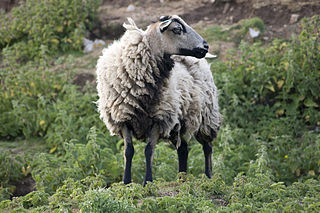
The Badger Face Welsh Mountain is a distinct variety of the Welsh Mountain breed of domestic sheep bred for Sheep farming in Wales. It is a hardy upland breed known for producing a high percentage of twins and triplets under good conditions. It appears in two sub-varieties of its own: the Torddu, which has a white fleece with dark face and belly, and the Torwen, which has a black body with a white belly and white stripes over the eyes. The Torddu is the more common of the two types. In both types, ewes are polled and rams are horned. Although this breed grows wool, it is primarily raised for meat.

The Pomeranian Coarsewool or simply Pomeranian is an old domestic sheep breed from the Pomerania region. The first records of similar sheep in Pomerania can be traced to more than 3000 years ago. This breed is raised primarily for meat and vegetation management.
The West African Dwarf or Djallonké is an African breed or group of breeds of domestic sheep. It is the dominant breed of West and Central Africa. This breed is primarily raised for meat.
Altay is a breed of domesticated sheep originating in the dry, cold mountain basins of China. This breed belongs to the fat-rumped carpet wool type of sheep and the Kazakh group. Although the Altay grows wool, it is raised primarily for the meat.

Algerian Arab sheep is a breed of domesticated sheep found throughout Algeria. This breed does grow a carpet-grade wool, and is raised primarily for meat.
The Balkhi is a domesticated breed of sheep found in Afghanistan and North-western Pakistan. This breed is of the fat-tailed mutton type. Though this breed does grow wool, it is primarily raised for meat.

The Bardoka or White Metohian sheep is a multi-purpose breed of domesticated sheep in Kosovo. It is a popular sheep in Kosovo and partially in Montenegro, Serbia and Albania. This breed appears to adaptable to all environmental conditions especially low temperatures. However, the Bardoka is sensitive to high humidity.
The Bibrik is a fat tailed, domesticated breed of meat sheep that is found in Baluchistan Province of Pakistan.
The British Milksheep is a robust, dual-purpose sheep commonly known for its milking characteristics.
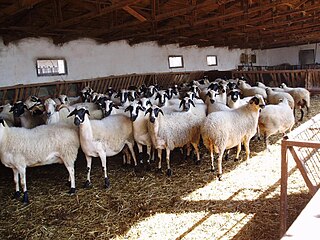
The Chios is a breed of domestic sheep with specific unknown origins. It is classified as a semi-fat tailed breed. The Chios are bred mainly for their milk production. Although there is speculation that this breed may have been crossed with Kivircik and Dagliç, it is commonly accepted that it originated on the Greek island of Chios.

The Coburger Fuchsschaf is a breed of domestic sheep from Germany. It is characterized by its reddish brown to golden color, which is most pronounced at birth, but remains at the head and the legs in the adult. Many animals also have a dorsal stripe.